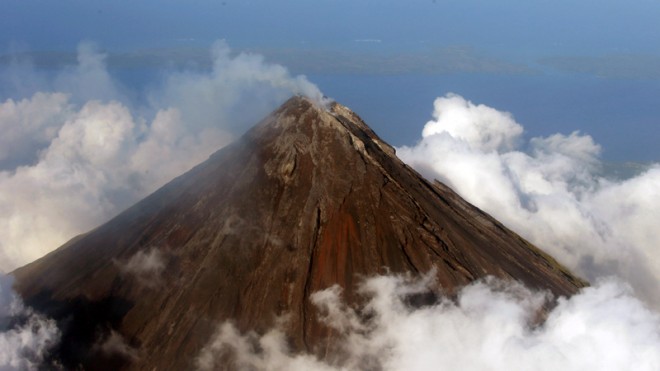Phivolcs not sure if Mayon eruption is vulcanian or strombolian

In this Feb. 26, 2014, file photo, smoke billows from the crater of Mayon volcano, one of the country’s most active volcanoes, in Albay province. As Mayon volcano seethed for the 12th straight day, experts have not established if the Philippines’ deadliest mountain is headed for a vulcanian type of eruption or a strombolian blast. AP PHOTO/BULLIT MARQUEZ
LEGAZPI CITY, Philippines—As Mayon volcano seethed for the 12th straight day, experts have not established if the Philippines’ deadliest mountain is headed for a vulcanian type of eruption or a strombolian blast.
Either one is deadly, as 26 Mayon blasts since 1616 have shown.
“The characteristics that Mayon is showing are [those] of a vulcanian eruption, or maybe even a strombolian eruption,” Director Renato Solidum of the Philippine Institute of Volcanology and Seismology (Phivolcs) told reporters on Monday.
A vulcanian eruption is characterized by strong explosions, multiple pyroclastic flows or a fast-moving mix of hot gas and rocks, and lava cascading down the volcano slopes.
A strombolian blast means a fairly quiet emission of lava down the slopes.
Mayon’s most destructive eruption occurred in February 1814 when the volcano killed 1,200 people and destroyed Cagsawa church.
Magma already in summit
Solidum said Phivolcs’ computation showed Mayon had emitted around 30 million cubic meters of magma in its present state of eruption, similar to what it expelled during a 2009 eruption.
“The volume of magma is just like the 2009 eruption,”he said. When magma solidifies, the 30 million cubic meters would be equivalent to 3 million truckloads of rocks.
Solidum said Mayon could not be considered to be in a “quiet eruption” because of the continuous volume of magma rising.
“We need to remind people that the magma is already there on the summit,”he said.
Pressure building up
Solidum said that based on Phivolcs’ observation, the “volcanic plug” or lava dome—pile of lava—blocking the crater was preventing the magma from coming out.

Solidum said that “if the crater is blocked, the pressure is building up even more inside.”
He said the present situation of the volcano “could be compared to a shaken bottle of soft drink. If you remove the cap, the soda would spill out quickly.”
Like an octopus
He said that in a vulcanian eruption, the swiftly moving hot gas and rocks could reach a radius of six kilometers from the crater while the ash fall could reach within a radius of 10 km.
A strombolian blast, however, is a low-level eruption. “When it happens, it would spew lava quietly or produce lava fountaining within 1 to 2 km [from the crater],” he said.
Cedric Daep, head of the Albay Public Safety and Emergency Management Office, said pyroclastic flows were like the tentacles of an octopus that would affect some areas of Legazpi, Ligao and Tabaco and the municipalities of Daraga, Camalig, Guinobatan, Malilipot and Sto. Domingo—all within a radius of 6 to 7 km from the crater.
He said a strombolian eruption could bring lava flow to the southeastern side of the volcano, such as areas in Legazpi, Daraga and Sto. Domingo.
Permanent houses
In its Monday morning bulletin, Phivolcs recorded two volcanic quakes and four rockfall events.
Solidum said the decrease in the activity of Mayon was not yet significant for Phivolcs to lower its alert level, raised to Level 3 on Sept. 15.
Gov. Joey Salceda said the provincial government planned to build permanent houses for thousands of families who would be displaced each time Mayon became restive.
He said the “forced relocation” of thousands of residents living within the danger zones would keep them away from harm’s way during an eruption.
Salceda said 2,898 families, especially those within the 6-km permanent danger zone, would be affected by a forced relocation.
Costly operation
He said the evacuation setup was very costly for the government, which spends P311 million for the three-month stay of evacuees in shelters.
In Manila, the Department of Education (DepEd) said it would release P23 million for the purchase of 15,000 chairs and the construction of 300 temporary learning spaces for schools currently occupied by evacuees from Mayon.
A total of 52,800 students in 39 schools have been affected by the evacuation of people in Albay province.
The DepEd is calling for donations for tents, tarps, chairs and learner’s kits for the affected students.
The United Nations Children’s Fund has committed to provide 175 tents and 400 tarpaulins to serve as temporary learning spaces, the DepEd said.–With Dona Z. Pazzibugan and Inquirer Research
Originally posted: 8:25 pm | Monday, September 29th, 2014
RELATED STORIES
Mayon still active, says Phivolcs exec